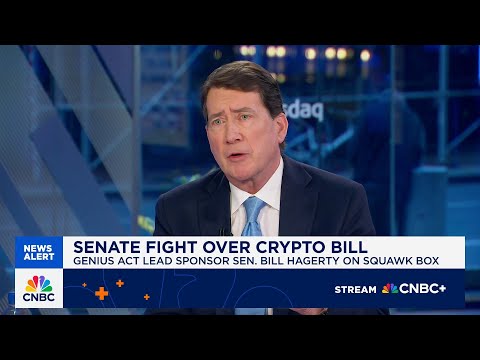
- The Senate advanced the “Genius Act,” marking historic bipartisan support for the first major stablecoin regulation bill in the U.S.
- The vote exposed shifting political alliances and deep rifts within the Democratic Party, especially regarding crypto oversight and conflict of interest concerns.
- Key controversies center on alleged gaps in regulatory oversight, Big Tech influence, and links to political figures, including the Trump family and associated digital assets.
- High-profile senators voiced warnings about the risks of inadequate guardrails, highlighting potential for crypto abuse and foreign influence.
- Public trust in stablecoin legislation remains fragile, with most Americans wary of unresolved conflicts of interest and ethical governance issues.
- The outcome will shape the future of stablecoin adoption, digital dollar innovation, and U.S. leadership in the global crypto economy.

The evening air in Washington pulsed with tension as the Senate’s chamber filled with anticipation. For the first time, a stablecoin bill—aptly nicknamed the “Genius Act”—crossed the formidable 60-vote threshold needed to silence debate, opening the door for a historic full Senate showdown that could reshape the crypto landscape in America.
Sixty-six senators—in a rare show of bipartisanship—voted to cut off endless filibuster, while thirty-two opposed and two remained silent. The tally revealed shifting political sands, especially among Democrats. Sixteen Democrats, a diverse coalition led by Senators Gillibrand, Alsobrooks, Gallego, and Warner, broke party ranks, punctuating the moment with fierce floor debates and tense sidebar negotiations. Observers caught glimpses of Senator Gillibrand in an animated dialogue with Republican champion Bill Hagerty, suggesting that behind-the-scenes bargaining remains relentless.
But amid the furious momentum, not every Democrat marched in lockstep. Senator Kim, previously supportive at committee level, balked at the procedural vote, deepening rifts on the left. Lawmakers like Senator Warren assailed the bill’s supposed oversight gaps, arguing that its latest version glosses over fundamental flaws—especially when weighed against the specter of potential abuse by Big Tech or political actors.
Conflict of interest alarm bells clanged louder with every passing minute. Senator Warner publicly voiced unease about the Trump family’s reported involvement in digital currencies, warning that foreign capital and opaque crypto dealings put everyday Americans at risk. Despite this, he acknowledged an urgent underlying reality: blockchain technology is not waiting on Congress, and failure to legislate could mean ceding ground to international adversaries.
Yet it was Senator Warren who shot down claims of progress, insisting that cosmetic revisions hadn’t addressed the bill’s core weaknesses. Her warnings echoed through the chamber, amplifying concerns that weak guardrails could let bad actors flourish.
None of these debates happen in a vacuum. The stablecoin question has become entangled with conflict-of-interest stories swirling around the $TRUMP memecoin—a digital token reportedly offering access to exclusive dinners with Donald Trump, funded by foreign investors and promoted by family backers. Layer on top the involvement of World Liberty Financial (associated with the Trump circle) and their USD1 stablecoin, which saw a $2 billion purchase by a UAE-linked firm led by the country’s national security advisor, and the stakes grow even higher.
Public sentiment appears divided but wary. Early reader polls showed three in four believe conflicts of interest abound; as word spread, skepticism softened only slightly. Far from a fringe concern, the question of ethical crypto governance could shape public trust for years to come.
Here’s the key takeaway: Whether one champions innovation or guards against exploitation, the Genius Act debate crackles with consequence. Will the Senate craft nimble guardrails for digital dollars, or will old suspicions and political friction condemn the nation to play regulatory catch-up? Americans, and indeed the world, are watching—because the decisions made today will ripple across tomorrow’s digital economy.
This New Stablecoin Law Could Change Cryptocurrency Forever—Here’s What Most Aren’t Telling You
# A Historic Senate Standoff Over Stablecoin Regulation: Hidden Facts, Pressing Questions, and Actionable Next Steps
The “Genius Act” just shattered a decades-old stalemate in Washington, but the bill’s Senate breakthrough is only the tip of a much larger—and riskier—iceberg for digital currency in America. While bipartisan momentum grabbed headlines, let’s dive deeper into what’s really at stake, how this law compares globally, who stands to win or lose, and what consumers and investors should do right now.
—
Additional Facts and Underexplored Angles
1. What Is a Stablecoin—and Why Does Regulation Matter?
– Definition: Stablecoins are cryptocurrencies pegged to stable assets, like the US dollar, designed to avoid the extreme volatility typical of other cryptocurrencies (e.g., Bitcoin, Ethereum).
– Use Cases: They’re used for remittances, rapid payments, DeFi (decentralized finance), and as on/off-ramps between fiat and crypto markets. (Source: Investopedia)
– Global Stakes: Countries like the UK, Singapore, and Japan have fast-tracked stablecoin regulation, aiming to attract fintech innovation while ensuring consumer protections. The U.S. risks falling behind if it delays.
2. The Bill’s Main Features (and What’s Missing)
– Focused Regulation: Sets out reserve and disclosure requirements for stablecoin issuers.
– Oversight: Empowers federal agencies (likely the Federal Reserve and SEC) with monitoring powers.
– Gaps:
– Unclear how foreign-backed or algorithmic stablecoins will be treated.
– Lacks explicit rules about conflict of interest and foreign money flows.
– Leaves ambiguous whether banks or fintech startups get easier licensing paths.
3. Controversies and Limitations
– Big Tech Concerns: The bill does not address if tech giants (e.g., Meta, Apple) can launch their own “dollar” coins, raising fears of monopolization or data misuse.
– Opaque Ownership: Political and familial ties (e.g., Trump memecoin) remain a gray area, with foreign capital concerns flagged but not deeply regulated in the bill.
– Enforcement: Questions remain about how violations will be prosecuted and if new agencies or task forces are needed.
4. Real-World Industry Impacts & Market Trends
– Market Growth: The global stablecoin market surpassed $150 billion in circulation as of March 2024 (source: CoinMarketCap).
– Consumer Adoption: U.S. stablecoins like USDC and USDT are essential for trading and cross-border remittances.
– Industry Winners and Losers: Banking giants (JPMorgan, Goldman Sachs) are building their own blockchain solutions; smaller startups could benefit if regulations allow for various issuer types.
5. Security, Sustainability, and Consumer Protections
– Security Risks: Poorly regulated stablecoins have historically “broken their peg” (e.g., TerraUSD collapse in 2022), wiping billions from users.
– Sustainability: The increasing energy efficiency of platforms (like Ethereum’s switch to Proof of Stake) means stablecoins are less environmentally damaging than early crypto.
– Consumer Recourse: The bill lacks strong deposit insurance or “bailout” guarantees—unlike FDIC protection for banks.
6. Tutorials & Best Practices: How To Use Stablecoins Safely
– Step 1: Only purchase stablecoins from recognized U.S. or EU-regulated issuers.
– Step 2: Use reputable wallet apps with two-factor authentication.
– Step 3: Regularly check issuer audits and transparency reports.
– Step 4: Transfer only what you can afford to lose; digital assets are not federally insured.
7. Insights, Predictions, and What to Watch Next
Expert Opinions: Leading economists and former regulators (e.g., Sheila Bair, ex-FDIC chair) argue that prompt, robust regulation is essential or U.S. consumers and companies risk being forced onto less-safe, foreign-run platforms (source: Brookings).
2024–2025 Forecast:
– Expect more comprehensive bills addressing conflicts of interest, possibly triggered by publicized scandals or foreign funding revelations.
– Tech companies and bank lobbies will increase pressure for favorable rules.
– U.S. Treasury likely to issue detailed guidance within the year.
—
Most Pressing Reader Questions—Answered
1. Will this new law make stablecoins safer?
– Partially. It signals regulatory clarity, but big gaps remain around ownership, foreign influence, and consumer insurance.
2. How does the U.S. approach compare internationally?
– Behind the Curve. The EU’s MiCA framework (Markets in Crypto-Assets Regulation) is already in effect, with stricter rules for issuers and consumer transparency.
3. Can politicians or their families profit from stablecoins under this law?
– As written, yes—unless amendments strengthen conflict-of-interest provisions.
4. Are my stablecoins protected like money in a bank?
– No. Stablecoin holdings are not insured by the FDIC or SIPC.
5. What if the bill fails in a final vote?
– Chaos. U.S. companies may move offshore and Americans may use less-regulated, more dangerous alternatives.
—
Pros & Cons Overview
Pros:
– Clarifies regulatory status of stablecoins
– Encourages American fintech innovation
– Bipartisan support may withstand party swings
Cons:
– Lacks strong consumer protections and conflict-of-interest rules
– Risks Big Tech or foreign money dominance
– May trigger legal turf wars among agencies
—
Actionable Recommendations & Quick Tips
– Diversify: Never keep all your savings in stablecoins; use them for short-term transactions.
– Audit First: Ask issuers for third-party reserve audits before buying.
– Stay Updated: Watch Senate news, as amendments could drastically change the bill.
– Advocate: Contact your senator if you have views on conflict-of-interest or consumer protection provisions.
– Learn More: Review educational resources on crypto from the U.S. Federal Trade Commission FTC.
—
Related Resources
– U.S. Securities and Exchange Commission: SEC
– CoinMarketCap: CoinMarketCap (for stablecoin market stats)
– Financial Times: Financial Times
—
The U.S. stands at a regulatory crossroads with stablecoins. Whether you’re an investor, policymaker, or simply a digital citizen, the time to get informed—and get involved—is now.
This post Senate Drama Over Stablecoins: What’s Fueling the Clash, and Why It Matters for America’s Digital Future appeared first on Macho Levante.

A former fintech consultant turned blockchain advocate, Bernard S. Mills brings over 15 years of financial industry experience to his crypto commentary. Known for his deep dives into decentralized finance (DeFi) protocols and market strategy, Bernard combines technical insights with real-world applications. When he’s not dissecting tokenomics, he’s mentoring startups in the Web3 space.







